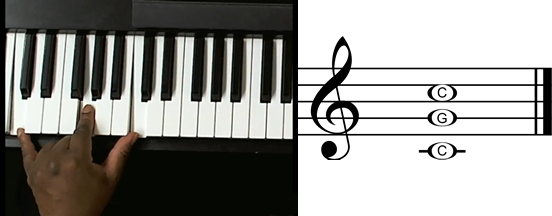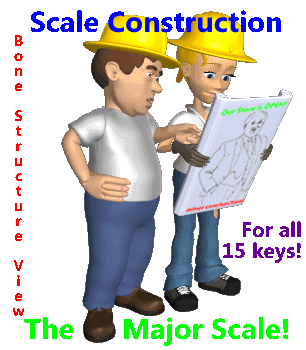Intro / Op-Ed
Since 3rds are made from scales and chords are made of couplings of various kinds of 3rds, I’ll start this post by saying a few words about scales and chords.
Scales, at their basic level, are formed by stringing and connecting a series of 2nds together and each note in the string may or may not have a modifying accidental attached to it. In the case of most traditional scales, like the major scale, every scale step and its letter name must be arranged in numerical and alphabetical order. Also, consecutive sequencing of the same letter name is not allowed (using the same letter name twice in a row is not allowed). At the root of all scales, you’ll find intervals.
Chords, at their most basic level, are formed by extracting every other note of any given scale which creates a series of connected 3rds and each note in a chord may or may not have a modifying accidental attached to it. At the root of all chords, you’ll find intervals.
Thirds
Thirds are very important intervals to understand because our system of harmony, tertian harmony, is based on them. Our musical alphabet uses only the 1st seven letters of our Arabic alphabet, A B C D E F G. However, for the reasons I mentioned in AC #10, I’ll use the same letter sequence but I’ll have the string start with C.
Now, to make a 3rd, simply follow theses 3 steps.
C D E F G A B
1. Select any letter from the 7-letter sequence.
(In doing that you’ve established the interval’s name and root… think of it as scale step “1”.)
2. Skip over “scale step 1’s” next-door-neighbor.
(In doing that you’re skipping over scale step 2 because your mission is to make a 3rd.)
3. Now, having skipped over scale step 2, select the very next letter in the sequence.
(In doing that, you’ve selected scale step “3” as the interval’s upper note and then you extract scales steps 1 and 3.)
That’s it! You’ve constructed a 3rd… a generic 3rd*.
*(All accidentals are omitted or ignored In generic intervals. Only staff position matters.)
When 3rds are stacked on top of each other in a totem-pole-like fashion, they form chords, and in order to understand chords, it’s critical that you understand 3rds in general and major 3rds in particular.
Understanding major 3rds.
Major 3rds are particularly significant because they are the intervals by which the basic major and minor tonality and functionality of chords and scales are distinguished or determined.
Major 3rds are formed by extracting the 1st and 3rd notes of any major scale. Even when you’re dealing with non-major 3rds, (like augmented, diminished, or minor 3rds etc.), you’re still dealing, with the same letter names of the 1st and 3rd notes of a major scale. The specific major scale with which you’re dealing is determined by the name of the 3rd’s lowest note. The interval’s functionality (major/minor etc.) is determined by the name of the 3rd’s upper or top note, and in the case of major 3rds, the top note is unmodified (diatonic–which means only scale tones are allowed). Further analysis of the major 3rd reveals that it is an extraction of the 1st and 3rd notes of a subset of major scale notes which I call the major trichord (major scale steps 1, 2, and 3)–not to be confused with the major triad (major scale steps 1,3, and 5).
For example: If you were to play the first 3 notes of the C major scale (C-D-E), you would have played scale steps 1-2-3, you would have covered the distance of two full whole steps, and you would have simultaneously played the C major trichord. When you extract only the 1st and 3rd notes of any major trichord, and/or any major scale, you’ve extracted a major 3rd.
When building major 3rds on a piano, either point below will help guide your construction.
1 – Place your fingers on the first 3 scale steps of any major scale you chose, then play the 1st and 3rd notes… (the outer “book-end” notes).
2 – Place your fingers on only 2 whole steps of any major scale you chose, then extract the 1st and 3rd notes… (the outer “book-end” notes).
Either process should lead you to a successful construction of a major 3rd.
More review, extra emphasis, a few cautious tips, and another hypothetical
3rds – These intervals are easily identified because of the contiguous way in which both letter names are alphabetically sequenced. With 3rds, the letter names of both notes will be alphabetically adjacent to exactly one letter in between them (the “skip-over” process mentioned just a few paragraphs above).
When written in standard music notation, both notes will be written in consecutive spaces or on consecutive lines, notwithstanding any accidentals which may be attached to either note.

Don’t let yourself be fooled by the sound or the physical spacing of your fingers on the piano keys when certain accidentals are used! Read your instrument panel and fly by the instruments!
On the piano keyboard, things can get a little trickier, as I illustrated with the hypothetical example in AC #35. Here’s another example. Look at the photo. What interval does that look like? Click the player… What interval does it sound like? Can you ID it beyond a shadow of a doubt?
The interval denies your assertion and cries, “Not guilty! Mistaken ID”! Can you be 100% certain of your ID?

I think NOT! You need more information! With the info you’ve been given, you just can’t be sure!
What looks like C might in fact be a B♯ or a D♭♭ and what looks like E could easily be D X or F♭. We could argue probability all day long and, in many cases, probability will get you by just fine! However, probability and certainty are two different things. I’ll probably agree with you as to what it looks, sounds, and feels like, but our deductions would only be guesses. Without some other type of corroborating evidence, we can’t be certain that the interval we see is even a 3rd!
Here’s what I think would happen to both of us if we were in some special type of people’s court trying to prove our interval ID case and our courtroom transcripts read something like this… “Judge it looks like such-and-such, and it sounds like so-and-so, and it feels like it might be a…
The Honorable Judge Umust B. Wright and bailiff Orville Tossit Outler BAM!!! The Judge stops our case mid-sentence during my argument and says…!
 BAM!!! “Case dismissed!” Click the player to hear the judge order his bailiff to show us the way out before calling me back for a sidebar. We were lucky to escape without being fined for wasting the court’s time! Now of course I’m just kidding around here but we really needed more information because our piano-scenario-only evidence was too inconclusive to prove anything. The Judge made the correct ruling!
BAM!!! “Case dismissed!” Click the player to hear the judge order his bailiff to show us the way out before calling me back for a sidebar. We were lucky to escape without being fined for wasting the court’s time! Now of course I’m just kidding around here but we really needed more information because our piano-scenario-only evidence was too inconclusive to prove anything. The Judge made the correct ruling!
In this particular hypothetical, you’ve been presented with both notes of an unknown interval on the piano keyboard without being told the note name of either piano key or anything about type of interval for which you’re looking. Also, you haven’t been given any other relevant, supportive information like a key signature, a sheet music representation, or replica of the interval. Under these circumstances, the interval might be a unison/1st or a 2nd, it could be a 3rd, it may be a 4th, and so on. You just don’t have enough info to definitively identify the interval pictured in the piano photo. In order to correctly identify the interval in this particular hypothetical, beyond the shadow of a doubt, you need to have the letter names of both notes of the interval.
Hopefully that’s all clear now and after a few more post-closing words, it’ll be time to take either the end-of-the-post-easy-quiz or a couple of aspirin! (:-)
Major 3rds occupy the 1st and 3rd notes of any given major scale. They occupy the outermost notes of 2 full whole steps. Once you’re able to clearly see and understand how to construct and analyze the major 3rd, analyzing, constructing, or identifying 3rds in any of their modified states should become a much easier task because each of the modifying accidentals that may be applied to the major 3rd is self-explanatory in terms of what it does to achieve its modification. Now that was a mouthful but trust me! This stuff is not difficult at all if you proceed on a step-by-step basis and don’t get ahead of yourself… or your teacher!
Let me ask you a question that’s unrelated to music. Once you learned your “ABCs”, how many times have you had to go back to re-study and re-learn the alphabet because you’d forgotten it? For most of you the answer is, “Not once”, because you studied and learned it thoroughly, and you use it in some form, every day of your life! The same thing applies to the language of music!
Thoroughly studying and learning the 15 major scales and their major intervals, by spelling them and writing them out, is what I recommend for you to do as a multi-week or multi-month project, once you’ve completed your study of intervals in this particular series of posts. There’s no rush or speed contest here! Just take your time, move systematically, and study thoroughly!
The most commonly used accidentals are shown in the lineup just below followed by examples of the most common occurrences of 3rds in the key of C.
♮ = natural
♯ = sharp
X = double sharp
♭ = flat
♭♭ = double flat
Major 3rd = C to E (The major 3rd is unmodified)
Augmented 3rd = C to E♯ (The major 3rd is sharped once)
Minor 3rd = C to E♭ (The major 3rd is flatted once)
Diminished 3rd = C to E♭♭ (The major 3rd is flatted twice)
This link will open an Acrobat/Adobe flash type of applet where you’ll be asked to correctly match ten intervals via a drag-n-drop process. Doing the exercise at least 4 or 5 times will give you an introductory workout on identifying and matching the intervals in C and other keys.
Study well and have fun,
See you next post,
 Okay! It’s time to take a look at the last interval of the series!
Okay! It’s time to take a look at the last interval of the series! 


 Clicking the treble staff or keyboard icon opens a respective interval ID page where numeric and quality values are required.
Clicking the treble staff or keyboard icon opens a respective interval ID page where numeric and quality values are required.



 Clicking the
Clicking the 










 The numeric information gives you an outlined overview of the scale steps. Counting each step, as you move along (1-2-3-4-5-6-7-8), helps with keeping you aware of exactly where you are at each step of the construction process.
The numeric information gives you an outlined overview of the scale steps. Counting each step, as you move along (1-2-3-4-5-6-7-8), helps with keeping you aware of exactly where you are at each step of the construction process. 


 BAM!!! “Case dismissed!” Click the player to hear the judge order his bailiff to show us the way out before calling me back for a sidebar. We were lucky to escape without being fined for wasting the court’s time! Now of course I’m just kidding around here but we really needed more information because our piano-scenario-only evidence was too inconclusive to prove anything. The Judge made the correct ruling!
BAM!!! “Case dismissed!” Click the player to hear the judge order his bailiff to show us the way out before calling me back for a sidebar. We were lucky to escape without being fined for wasting the court’s time! Now of course I’m just kidding around here but we really needed more information because our piano-scenario-only evidence was too inconclusive to prove anything. The Judge made the correct ruling!